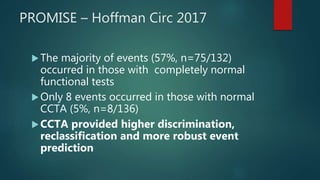Coronary ct angiography in the er
- 1. Coronary CT Angiography in the ER STEPHEN FLEET, M.D. CARDIOLOGY SEPTEMBER 2021
- 3. Chest Pain Types relative to CAD Clearly atypical CP Low to intermediate probability of CAD/ACS Most probably ACS (MI or unstable angina). We are concerned with the 2nd type.
- 4. Current Standard of Care History and Physical EKG Troponins If negative and depending on time of day, wait in ER or admit Nuclear stress test Discharge if stable
- 7. Problems with SOC Time Consuming Costly Limited Sensitivity and Specificity
- 9. Obstructive CAD at Cath: NCDR 2005-2007 Patel MR, Peterson ED, Dai D, Brennan JM, Redberg RF, Anderson HV, Brindis RG, Douglas PS. NEJM. 2010 Mar 11;362(10):886-95
- 10. NEW PARADIGM WHY NOT START WITH AN ANATOMIC STUDY, WHICH CAN ACTUALLY SHOW YOU IF THERE IS SIGNIFICANT NAMELY, CORONARY CT ANGIOGRAPHY.
- 11. ADVANTAGES READILY AVAILABLE NOW AT CHESHIRE MEDICAL CENTER TIME SAVING; MORE EFFICIENT LESS COSTLY SUPPORTED BY MULTIPLE STUDIES OVER APPROXIMATELY 15 YEARS
- 12. METHODS - CTA 0.5-0.625 mm slices Single Breath-hold Imaging 50-60 cc Non-ionic (IODINATED) contrast 20 minute procedure 15 minute interpretation
- 13. First Author Technique Patients Not evaluable Sensitivity Specificity Negative Predictive Value Leschka 64-slice CT 67 -- 94% 97% 99% Leber 64-slice CT 59 7% 73% 97% 99% Ehara 64-slice CT 69 8% 90% 94% 95% Raff 64-slice CT 70 12% 86% 95% 98% Fine 64-slice CT 66 4% 95% 96% 92% Ropers 64-slice CT 82 4% 95% 93% 99% Mollet 64-slice CT 52 2% 99% 95% 99% Nikolaou 64-slice CT 72 10% 86% 95% 97% Schlosser 64-slice CT 61 100% 95% 100% M├╝hlenbruc 64-slice CT 51 - 87% 95% 98% Meijboom 64-slice CT 104 - 92% 91% 99% Schuijf 64-slice CT 60 - 85% 98% 99% Oncel 64-slice CT 80 - 96% 98% 99% Herzog 64-slice CT 50 - 89% 92% 97% Ehara 64-slice CT 69 8% 90% 94% 95% Shabestari 64-slice CT 143 2% 94% 97% 97% Cademartiri 64-slice CT 72 0% 100% 98.6% 100% Hausleiter 64-slice CT 114 8% 92% 92% 99% Meijboom 64-slice CT 254 - 88% 94% 99% Andreini 64-slice CT 200 3% 99% 96% 100%
- 14. Lesion Grade Parameters % # of subjects by ICA # of subjects by CCTA Ōēź50% Sensitivity 95 49 45 Specificity 83 180 143 PPV 64 80 45 NPV 99 146 143 Ōēź70% Sensitivity 94 28 26 Specificity 83 201 163 PPV 48 61 26 NPV 99 165 163 Accuracy Trial ŌĆō Budoff et al JACC 2008
- 15. + CT
- 16. On to the cath lab
- 18. And...
- 19. A LA CASA! PHOTO BY ANDREA DAVIS
- 23. Date of download: 1/4/2016 Copyright ┬® The American College of Cardiology. All rights reserved. From: Coronary CT Angiography for Suspected ACS in the Era of High-Sensitivity Troponins: Randomized Multicenter Study J Am Coll Cardiol. 2016;67(1):16-26. doi:10.1016/j.jacc.2015.10.045 Length of Stay and Discharge Rate From the ED in the ACRIN-PA, ROMICAT-2, and BEACON Trials Reported data are medians. ACRIN-PA = American College of Radiology Imaging Network-Pennsylvania; BEACON = Better Evaluation of Acute Chest Pain with Computed Tomography Angiography; ROMICAT = Rule Out Myocardial Infarction using Computer Assisted Tomography; other abbreviations as in Figure 1. Figure Legend:
- 25. ŌĆ£State of the ARTŌĆØ Coronary CTA Identifies normal patients ŌĆō 99% NPV Identify patients in need of preventative medical treatment (statin and ASA) Efficient triage for reduced down stream testing and revascularization Useful for prognosis and assessment of plaque Excellent for patients with low to intermediate risk of ACS compared to current SOC Endorsed by Peer Reviewed International Standards Groups and Insurance carriers, ESC and AHA/ACC
- 26. CAVEATS Works best for mild to moderate risk patients Avoid complex coronary anatomy, CABG, and small stents Vasculopaths High coronary calcium suspected High heart rates that canŌĆÖt be controlled
- 27. In Review: Proposed Chest Pain Management Very low risk chest pain; diagnose and send home Low to intermediate risk: coronary CT angiogram Moderate to high risk: nuclear stress test Very high risk: to cath lab
- 28. PROMISE ŌĆō Hoffman Circ 2017 ’üĄThe majority of events (57%, n=75/132) occurred in those with completely normal functional tests ’üĄOnly 8 events occurred in those with normal CCTA (5%, n=8/136) ’üĄCCTA provided higher discrimination, reclassification and more robust event prediction





























